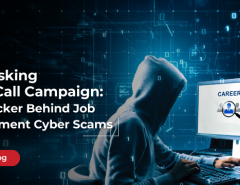Ransomware is scary. Anyone who has ever been the victim of a ransomware attack or seen the havoc WannaCry unleashed, would agree. And it is not a threat that seems to be going away anytime soon – the European Agency for Law Enforcement Cooperation (Europol) observed that ransomware remains the key malware threat in both law enforcement and industry reporting, in their Internet Organized Crime Threat Assessment 2018. The report also indicated that ransomware will continue to flourish.
By now, most organizations are familiar with the way ransomware operates. Hackers gain access to systems and encrypt the data, hence locking the original user out. The original users are threatened that their information will be deleted or leaked unless they pay an amount of ransom (mostly in the form of a cryptocurrency like Bitcoin) after which they will get the key to decrypt their data.
The havoc ransomware causes
Organizations have also started waking up to the importance of employing anti-ransomware protection to ensure they stay protected. But sometimes, desperate times call for desperate measure. In the event of a ransomware attack at any organization, small or big, chaos can reign. Operations come to a halt, money is being lost exponentially every second, the brand’s reputation is sinking with every second and the media is right at the doorstep. At this point, the temptation to just give in – accede to the hacker’s demands and pay the ransom, is just too much. Many companies are sorely tempted to pay up and just buy themselves some peace.
The short and simple answer is: Don’t. Your quick-fix solution could potentially lead to a disastrous long-term impact.
Don’t pay
An advisory about ransomware from the United State Computer Emergency Readiness Team (US-CERT) from 2016 succinctly summed up why enterprise owners and network administrators should never accede to ransom demands:
Paying the ransom does not guarantee the encrypted files will be released; it only guarantees that the malicious actors receive the victim’s money, and in some cases, their banking information. In addition, decrypting files does not mean the malware infection itself has been removed.
The three sentences make the perfect point. Even if your enterprise has been stuck down with ransomware and the costs are spiraling, there is no guarantee that you will get your files back. Absolutely no guarantee. Keep in mind that those who have hacked into your systems and stolen your data are criminals – they have no code of conduct or honor to follow. In fact, they may never have even planned to release the stolen data because that only will lead them to a bigger chance of being caught.
From the frying pan into the fire
In such a scenario, your enterprise is in a complete fix. Your data is gone and you’ve lost more money. Worse, your banking details have been provided to criminals, opening you to even more risks. And now the criminals are more emboldened since they know you’re a target who is willing to pay. Don’t count out more ransomware attacks against you as the word spreads in the market.
Even in the unlikely event that the criminals actually release the data, that doesn’t mean all your problems are solved. It is quite likely that your data by itself will be released but the original malware infection itself is still there. That means you are at the mercy of the hackers and they can carry out another attack whenever they desire.
Instead, take the smarter path and choose Seqrite’s Endpoint Security (EPS) solution which offers a comprehensive security for workstations, laptops and servers which integrates various advanced features including Anti Ransomware. Seqrite EPS was certified BEST+++ by AVLab – the EPS Enterprise Suite edition was 100% effective in detecting and blocking malicious files of crypto-ransomware thus earning the AVLab BEST+++ award.
As an IT security partner for your business, Seqrite provides comprehensive security from advanced cyber threats. To know more




